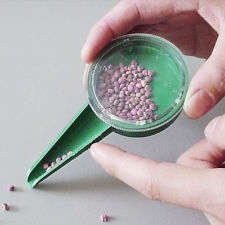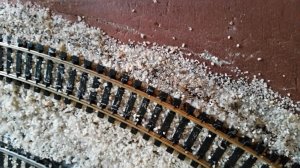Basically, what you are going to do is spread some very fine gravel over your tracks, smooth it out using small brush or tooth brush, then get it wet so the glue will soak into it.
Nothing really exacting here. You can find ballast spreaders on the internet or in hobby shops that help ya spread your ballast over your track, but then ya have to go back over it to get the ballast laid right then come back on the forum and tell everyone what a waste of money the ballast spreader is.
Once the ballast is the way you want it, ya need to glue it down. Now if you just put Elmer's glue on the ballast, the glue would just bead up and dry in clumps. I'm sure ya don't want that, so ya need to thin the glue out a bit. I usually use a 1:1 mix or there abouts. Nothing really exacting. I use an old ketchup squeeze bottle for this. Fill it half way with wet water and the rest with Elmer's glue, put the cap on it and shake it up. Yep, I said "wet water". Once again, if you just put water on the ballast, it would bead up without soaking it. Ya need to break the water surface tension so it will soak into the ballast. You can do this using liquid dish soap. It has glycerin in it which breaks that surface tension and then the water will soak down into the ballast. Use a Windex type spray bottle. Put some dish soap in it first. For a 16oz bottle, a half thimble full of soap should be adequate. I think that might equate to about 1/4 teaspoon of dish soap. Once again, nothing real exacting here. Fill it with cold water, real slow so it doesn't foam up. Do the same with the water that ya mix with the glue.
Ok, ya have your ballast spread out along a three foot section of track, spray the wet water onto the ballast until it is soaked down to the road bed then use the ketchup bottle and spread the glue, first down between the rails. A couple of lines of glue will do, then along each outside of the rails, then down along the embankment of the roadbed. You can see where the glue is on the ballast. Once you have done this, don't touch the ballast. You can touch it up by just dropping ballast where you can see it's kinda thin or missing on the roadbed. Spray it again then some glue. Set up a fan to have moving air over it and allow it to dry for a few hours. Clean the rail surface off before running trains and you are done.



